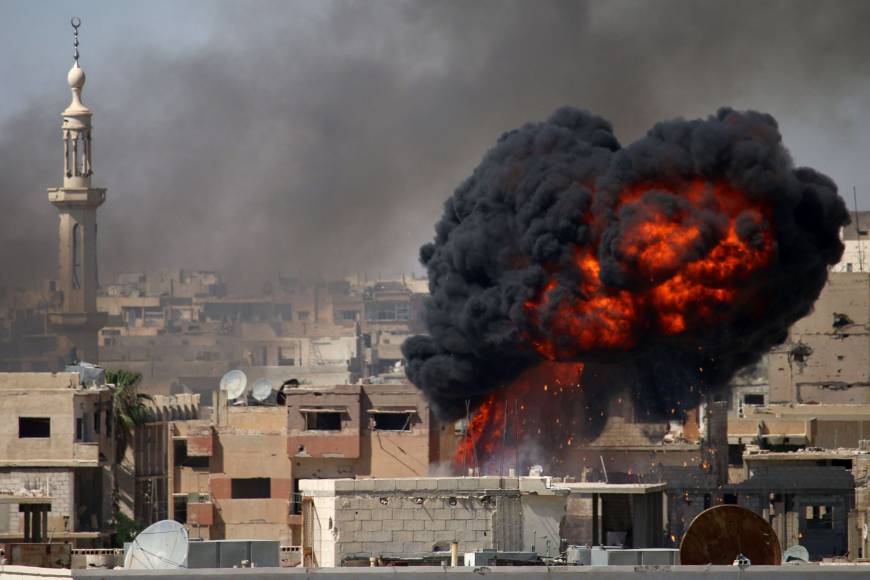Assad’s military declares suspension after failure to advance in Daraa city, despite weeks of bombardment
LATEST
- US Marine Unit Using Specialized Guidance for Shelling
- US: Kurdish-Led SDF Enters Old City of Raqqa
- Free Syrian Army: We Will Help International Organization Examine Sites of Latest Regime Gas Attacks
TUESDAY FEATURE
US to UN: Fate of Assad and Syria Now in Russia’s Hands
The Assad regime’s military said on Monday that it suspended combat operations in southern Syria for five days.
The military said in a statement on State TV the ceasefire began at noon to support “reconciliation efforts”. It will expire at the end of Thursday.
However, rebels said that regime warplanes already resumed the droppoing of barrel bombs on and divided Daraa city, close to the Jordanian border.
Pro-Assad forces have carried out intensive shelling and air attacks with hundreds of bombs, missiles, and “elephant” rockets in recent weeks in an attempt — unsuccessful so far — to regain parts of Daraa city taken by rebels this spring. These include the strategic Manshiyah area with government and security buildings.
The suspension also covers Quneitra Province in southwest Syria, where clashes between pro-Assad forces and rebels brought three Israeli strikes on regime positions in the last two weeks. The Israelis said rocket fire from the clashes had struck the Israeli-occupied Golan Heights.
A rebel official said the declared suspension was a ploy to bring the opposition back to talks in the Kazakh capital Astana, begun in January. In the last round in May, Russia — supported by Turkey and Iran — declared four de-escalation zones, one of which is in the south. But the Russians have never made clear if the southern zone covers Daraa city and nearby areas.
The Syrian opposition has stepped back from the Astana talks, saying that the Assad regime has not met demands to halt bombing, end sieges, and free political detainees.
“This ceasefire is an attempt by the Russians and the regime to bring back the opposition to Astana and give them assurances on the ground they will stop the shelling on condition they attend,” said Sohaib al-Raheel, spokesman of the Free Syrian Army’s Liwa al-Furqan Brigades.
Major Issam al-Reyes, spokesman for the Southern Front rebel bloc, said the grous were “very distrustful” of the regime military’s adherence to the ceasefire or Russia’s readiness to check the Assad regime:
We had cast doubt on the ceasefire the moment it was announced and knew it would not be different from previous ones. The regime is lying and the Russians are lying and are not serious in achieving a ceasefire.
The Russians are duplicitous and procrastinating and are part of the problem and so cannot be part of it solution.
US: Kurdish-Led SDF Enters Old City of Raqqa
US Central Command says the Kurdish-led Syrian Democratic Forces have entered the Old City district of Raqqa, the Islamic State’s main position in Syria.
CENTCOM said the US-supported SDF advanced by opening two small gaps in the Rafiqa wall, amid “heavy ISIS resistance” that included mines, improvised explosive devices, heavy machine guns, rocket- propelled grenades, and snipers.
Backed by US airstrikes, the SDF has been advancing inside Raqqa from the west and east since early June. They have also cut off ISIS to the south by taking the southern bank of the Euphrates River.
ISIS have held Raqqa since late 2013.
US Marine Unit Using Specialized Guidance for Shelling
A US Marine artillery unit in Syria is using a highly-specialized guidance kit for artillery shells, the first time the equipment has been used in a combat zone outside of Afghanistan.
A video on a Pentagon-run website shows an M777A2 howitzer with a row of 155mm artillery shells nearby. Two of the shells appear to be equipped with the XM1156 Precision Guidance Kit.
The kit reduces the circle around a target, at the howitzer’s maximum range of around 18 miles, from 853 feet to under 100 feet.
The Marine artillery unit is likely the 24th Marine Expeditionary, which is supporting the Kurdish-led Syrian Democratic Forces in their offensive to take the ISIS-held city of Raqqa in northern Syria.
Free Syrian Army: We Will Help International Organization Examine Sites of Latest Regime Gas Attacks
The Free Syrian Army has issued a statement that it will help international organizations examine the sites of the latest claimed “toxic gas” attacks by the Assad regime.
Rebels said last weekend that the regime carried out two attacks, possibly with chlorine, amid fighting in the East Ghouta area near Damascus. The first attack on Ein Tarma led to 31 victims of suffocation, while the second on Zamalka injured 10 people.
See Syria Daily, July 2: Rebels Claim Regime Chlorine Attack Near Damascus
Meanwhile, a concerned Russia has tried to push back the latest disclosures over the chemical attacks by declaring that Western officials are writing the reports from Syrian witnesses and activists.
Moscow has been unsettled by last week’s reconfirmation by the Organization for the Prohibition of Chemical Weapons that “sarin or a sarin-like substance” was used to kill at least 92 people and wound almost 600 in the town of Khan Sheikhoun in northwest Syria on April 4. Russia has tried a variety of stories to divert blame from the Assad regime, while Bashar al-Assad has said that the incident is “100% fabrication”.
Russian Foreign Ministry Maria Zakharova wrote on Facebook on Tuesday, “The ‘chemical show’ is gaining momentum.” She asserted that reports of last weekend’s chlorine attack were “drawn up according to all the rules of Western press services” and in “the language of international legal communication” used by “Western colleagues”.

